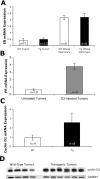Paracrine overexpression of insulin-like growth factor-1 enhances mammary tumorigenesis in vivo
- PMID: 18688034
- PMCID: PMC2527085
- DOI: 10.2353/ajpath.2008.071005
Paracrine overexpression of insulin-like growth factor-1 enhances mammary tumorigenesis in vivo
Abstract
Insulin-like growth factor-1 (IGF-1) stimulates proliferation, regulates tissue development, protects against apoptosis, and promotes the malignant phenotype in the breast and other organs. Some epidemiological studies have linked high circulating levels of IGF-1 with an increased risk of breast cancer. To study the role of IGF-1 in mammary tumorigenesis in vivo, we used transgenic mice in which overexpression of IGF-1 is under the control of the bovine keratin 5 (BK5) promoter and is directed to either the myoepithelial or basal cells in a variety of organs, including the mammary gland. This model closely recapitulates the paracrine exposure of breast epithelium to stromal IGF-1 seen in women. Histologically, mammary glands from transgenic mice were hyperplastic and highly vascularized. Mammary glands from prepubertal transgenic mice had significantly increased ductal proliferation compared with wild-type tissues, although this difference was not maintained after puberty. Transgenic mice also had increased susceptibility to mammary carcinogenesis, and 74% of the BK5.IGF-1 mice treated with 7,12-dimethylbenz[a]anthracene (20 microg/day) developed mammary tumors compared with 29% of the wild-type mice. Interestingly, 31% of the vehicle-treated BK5.IGF-1 animals, but none of the wild-type animals, spontaneously developed mammary cancer. The mammary tumors were moderately differentiated adenocarcinomas that expressed functional, nuclear estrogen receptor at both the protein and mRNA levels. These data support the hypothesis that tissue overexpression of IGF-1 stimulates mammary tumorigenesis.
Figures







Similar articles
-
Developmental stage determines estrogen receptor alpha expression and non-genomic mechanisms that control IGF-1 signaling and mammary proliferation in mice.J Clin Invest. 2012 Jan;122(1):192-204. doi: 10.1172/JCI42204. Epub 2011 Dec 19. J Clin Invest. 2012. PMID: 22182837 Free PMC article.
-
Overexpression of an N-terminally truncated isoform of the nuclear receptor coactivator amplified in breast cancer 1 leads to altered proliferation of mammary epithelial cells in transgenic mice.Mol Endocrinol. 2005 Mar;19(3):644-56. doi: 10.1210/me.2004-0106. Epub 2004 Nov 18. Mol Endocrinol. 2005. PMID: 15550471
-
Prepubertal exposure to cow's milk reduces susceptibility to carcinogen-induced mammary tumorigenesis in rats.Int J Cancer. 2011 Jan 1;128(1):12-20. doi: 10.1002/ijc.25313. Int J Cancer. 2011. PMID: 20232392 Free PMC article.
-
IGF and insulin action in the mammary gland: lessons from transgenic and knockout models.J Mammary Gland Biol Neoplasia. 2000 Jan;5(1):19-30. doi: 10.1023/a:1009559014703. J Mammary Gland Biol Neoplasia. 2000. PMID: 10791765 Review.
-
The hyperplastic phenotype in PR-A and PR-B transgenic mice: lessons on the role of estrogen and progesterone receptors in the mouse mammary gland and breast cancer.Vitam Horm. 2013;93:185-201. doi: 10.1016/B978-0-12-416673-8.00012-5. Vitam Horm. 2013. PMID: 23810007 Review.
Cited by
-
Serum insulin-like growth factor 1 correlates with the risk of nodal metastasis in endocrine-positive breast cancer.Curr Oncol. 2013 Aug;20(4):e283-8. doi: 10.3747/co.20.1380. Curr Oncol. 2013. PMID: 23904766 Free PMC article.
-
Adverse outcome pathways for ionizing radiation and breast cancer involve direct and indirect DNA damage, oxidative stress, inflammation, genomic instability, and interaction with hormonal regulation of the breast.Arch Toxicol. 2020 May;94(5):1511-1549. doi: 10.1007/s00204-020-02752-z. Epub 2020 May 13. Arch Toxicol. 2020. PMID: 32399610 Free PMC article. Review.
-
Targeting the IGF-Axis for Cancer Therapy: Development and Validation of an IGF-Trap as a Potential Drug.Cells. 2020 Apr 29;9(5):1098. doi: 10.3390/cells9051098. Cells. 2020. PMID: 32365498 Free PMC article. Review.
-
The Non-coding Mammary Carcinoma Susceptibility Locus, Mcs5c, Regulates Pappa Expression via Age-Specific Chromatin Folding and Allele-Dependent DNA Methylation.PLoS Genet. 2016 Aug 18;12(8):e1006261. doi: 10.1371/journal.pgen.1006261. eCollection 2016 Aug. PLoS Genet. 2016. PMID: 27537370 Free PMC article.
-
A high protein moderate carbohydrate diet fed at discrete meals reduces early progression of N-methyl-N-nitrosourea-induced breast tumorigenesis in rats.Nutr Metab (Lond). 2010 Jan 10;7:1. doi: 10.1186/1743-7075-7-1. Nutr Metab (Lond). 2010. PMID: 20148110 Free PMC article.
References
-
- Surmacz E. Function of the IGF-I receptor in breast cancer. J Mammary Gland Biol Neoplasia. 2000;5:95–105. - PubMed
-
- Yu H, Rohan T. Role of the insulin-like growth factor family in cancer development and progression. J Natl Cancer Inst. 2000;92:1472–1489. - PubMed
-
- Stewart AJ, Johnson MD, May FE, Westley BR. Role of insulin-like growth factors and the type I insulin-like growth factor receptor in the estrogen-stimulated proliferation of human breast cancer cells. J Biol Chem. 1990;265:21172–21178. - PubMed
-
- Silberstein GB. Postnatal mammary gland morphogenesis. Microsc Res Tech. 2001;52:155–162. - PubMed
Publication types
MeSH terms
Substances
Grants and funding
LinkOut - more resources
Full Text Sources
Molecular Biology Databases
Research Materials
Miscellaneous

